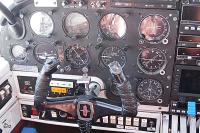Retiring an older personal web page with similar information, below is a list of some of my favorite slightly oddball films.
| 1964 | Dr. Strangelove |
| 1967 | The Prisoner (series) |
| 1975 | Rocky Horror Picture Show |
| 1980 | Airplane! |
| 1982 | Blade Runner |
| 1983 | Monty Python’s Meaning of Life |
| 1984 | Ghostbusters |
| 1984 | This is Spinal Tap |
| 1985 | Brazil |
| 1985 | Max Headroom |
| 1986 | True Stories |
| 1990 | Rosencrantz and Guildenstern Are Dead |
| 1990 | The Cook, The Thief, His Wife, and Her Lover |
| 1993 | The Nightmare Before Christmas |
| 1993 | Falling Down |
| 1994 | Exotica |
| 1994 | Mary Shelley’s Frankenstein |
| 1995 | Don Juan DeMarco |
| 1996 | Bound |
| 1996 | Twelve Monkeys |
| 1996 | Arli$$ (series) |
| 1997 | Mother |
| 1997 | Lexx (series) |
| 1997 | Romeo + Juliet (Baz Luhrmann’s |
| 1997 | Starship Troopers |
| 1997 | Cube |
| 1998 | Dark City |
| 1998 | The Truman Show |
| 1998 | Last Night |
| 1998 | The Big Lebowski |
| 1999 | Fight Club |
| 1999 | Being John Malkovich |
| 1999 | Mystery Men |
| 1999 | South Park: Bigger, Longer, Uncut |
| 2000 | After Life |
| 2000 | Chicken Run |
| 2000 | Waydowntown |
| 2001 | The Dish |
| 2001 | Zoolander |
| 2001 | Novocaine |
| 2001 | Intacto |
| 2001 | My First Mister |
| 2002 | Punch Drunk Love |
| 2003 | Lost in Translation |
| 2003 | Slings and Arrows (series) |
| 2003 | Dead Like Me (series) |
| 2003 | The Fog of War |
| 2003 | Nothing |
| 2004 | Eternal Sunshine of the Spotless Mind |
| 2004 | The Last Casino |
| 2004 | Kontroll |
| 2004 | Childstar |
I don’t care about the Live 8 show. But others seem to, and make some pretty good babble.
For example, somewhat popular blogger Tim Bray opines that western agricultural policy is guilty of
deliberately, and as a matter of policy, promoting poverty and starvation in the world’s poorest countries […] What’s happening now is evil, just evil.
The argument for this indictment consists of admitted speculation that, in the absence of subsidies for one’s nation’s farmers, African farmers might be competitive. Yes, he even admits the tenuous connection:
What would happen if the rich part of the world abolished agricultural subsidies and trade barriers tomorrow? There’s only one sane answer: we don’t know.
So, on one hand, he claims that starvation of some ethiopian peasant woman is an explicit goal of western governments, as if that was a specific and desired effect of agricultural subsidies. On the same page, he says removing the subsidies may or may not have a beneficial effect. That implies that the western governments are being misguided about their weapon of choice: killing said ethiopian would be more effectively achieved by bombs than subsidies. Oops, don’t give them any ideas!!!
I predict that these subsidies will stay for a long time. They’re of course not a good thing for free market capitalism, in the same way that compulsory “wheat pools” distort the market, but there is an element of national security that might excuse their existence. I don’t know. But the chance of all the major nations will concurrently drop them is teeny. Dropping subsidies unilaterally is suicidal, so its likelihood is even smaller.
Lock your doors! Hide your babies! The Little Tikes Wide Activity Walker is a death trap.
Whoever designed this walker must have skipped highschool physics. This walker is only safe when forward pressure is applied at the handle, otherwise the walker tips. So, a pretoddler learning how to walk can never lean to the side or back without someone making sure the walker isn’t going to fall. To be fair there is a warning label on the unit stating adult supervision is required, but the adult in the advertisment will just get a good view of the walker crashing down on the little person.
This afternoon, I went flying to practice some exercises similar to the ones in the multi-engine flight test. I was relieved that I could probably pass the test again. Still it required a good deal of effort, and brought back some bad memories.
Here are some of my humble findings about GXRP, a fine Piper Aztec specimen, in point form:
- Take-off pitch trim is actually satisfactory when cranked into the marked region on the overhead trim indicator. Vernacular suggests a lesser amount: “five or six” turns of nose-up, but this is a bit too little.
- Stalls give plenty of warning, with the whole airframe shaking.
- A stall break, especially if in a dirty configuration, is just unpleasant. It’s beyond the weird feeling of unresponsive controls. Wing drops occur, and are chilling because of the proximity to incipient spins, which are bad news for twins. Full recovery from a deep stall, including acceleration, cleanup, and climb, can take a long time – 15-30 sec.
- The single-engine ceiling of the airplane under lightly loaded conditions (4400lb today) is pretty much at book value: around 8000 ft.
- A single-engine approach to landing is a non-event. Flaps stay up; gear comes down at the usual time. A higher than usual but still only 60% power on the working engine is plenty to keep the descent profile and speed normal.
- Circuits at various speeds and deliberate screwups (too high, too fast, too little drag, too late) can generally be made to work out in a successful safe landing. Yes, generally it’s better to go around and try again, but it is a nice confidence-booster to get the bird down even in far-from-ideal starting conditions.
- A normal VFR circuit is easily done at the top of the white arc (around 120 mph) with baby flaps and gear down. Maintain speed and configuration until short final. When landing is assured, drop remaining flaps, set idle power, and slow down to around blue line (Vyse = 100 mph) in anticipation of the flare. This schedule works even if one engine dies during the circuit.
- Canyon turns don’t seem to be greatly helped by full flaps. An ordinary 60-degree steep turn at high power yanks even the clean airplane around in seconds.
Some quickie one-liners today.

Item: Juimiin’s little tikes for the trash article reminded me of the above photograph.
Item: A follow-on from this batch of Toronto government propaganda, we now pay for building-sized versions of the above picture. To speak the full truth, they might include an admission that fish poo from the lake ends up in your tap. Yes, incoming water gets purified somewhat. But the mentality seems just so urban: all that’s dirty or smelly must come from people. It all makes one want to read some poetry.

Item: UPS is a poor courier for US-to-Canada mail order. The customs brokerage fee they regularly charge, $48, is much higher than others. Consider FedEx or plain old USPS instead.
Ladies who breastfeed their offspring in summer’s sizzling midsection may be doing a disservice.
On such a hot day, the last thing little offspring will want is a slimy yellow goo that comes pre-heated to 36.9 degrees celsius. The incipient heat stroke that is the lot of many a human can only be cold cured: cold air and cold drinks.
The first can be satisfied by a properly working air conditioner. Due to the perpetual need for maintenance, and the utter impossibility to find timely technical service during summertime, few air conditioners are actually working properly any given time. Even if the machine is working acceptably, perforation of the house’s air enclosure is unavoidable, if Fido wants his hourly pee. And perforation leads to performance perturbation.
The second can be a problem. Not all mammalian mothers are equipped with a supply management device such as a breast pump and a refrigerator. For some, it’s a matter of affordability (good ones cost $300+); for some it’s a case of the Yuks; and some just can’t be bothered. Even those thusly equipped may not have a steady enough supply schedule to accumulate sufficient nice cold moo juice.
The solution? Refrigerate the moo juice before it leaves the mother. How? Three words: ice pack brassiers. If moulded into fashionable shapes, it could make the mother look even more … motherly, if you know what I mean.
Oh, by the way, don’t you dare try to steal this idea, even though only a man could possibly come up with it. It’s mine, and I’m not telling anyone.
I hate advertisements, and I fear+loathe the minds behind it.
The first insight is that advertisement is all about wish fulfillment. When they show you some skimpy babe and a boastful car, a beer can, or a bank account, in the same commercial ditty, they hope your brain learns that those things are associated.
They hope that whenever you think “ooh, I want that skimpy babe – she looks like a great backgammon partner”, you will also think “aah, I need a new chequing account – so I can pay that backgammon set with new shiny cheques”. Of course, it’s totally absurd from a logical point of view, but that doesn’t matter. They count on your receptive and partially-palliative brain drawing such conclusions when you just sit there, look at that, listen to this.
To assess to what extent your cohumans are susceptible, consider an experiment. Whenever a commercial comes on, take control of the situation and attenuate the content. Turn the volume down; drown out the happy music with laughter; stand up and get out your backgammon set. If your cohumans tolerate this, there is still hope. If on the other hand, they rant and rage that they can’t have their beloved commercials, you better watch out. You won’t want to be around when they finally discover that this flashy car doesn’t sound like a rock band, and driving one won’t automatically make every pedestrian want to make out with you, and really is just another car.
As sad it is to imagine all this, I can’t help but giggle when a particularly demeaning, intelligence- or honour-insulting advertisement comes on. But I sigh when I realize that, contrasted with the early days of television where leading characters would be of professions such as teachers, engineers, astronauts, soldiers, today the leading characters tend to be in public relations, marketing, politics, and such other evil wusses.
My ex-cow-orker Ben Elliston is by and large a great guy. A great, large guy.

Yes, he’s paying me to say that. Or at least he should.
You must have heard by now that several of the people identified as the likely London bombers were typical disaffected youth.
They apparently took up islam fervently in mid-late teenagehood, and fell off the deep end. It makes me wonder: what is it about islam that is so suitable for taking unhappy young people and turning them into monsters? Is it the same thing that formed the Hitlerjugend? Mao’s “Red Guards”? Criminal gangs?
Here is what the first flight aboard an airplane like GXRP might be like for a young pilot. Imagine a flight instructor hovering around, as the story unfolds.

You walk toward the airplane. It’s considerably larger than the two- or four-seat trainers you’re used to. The tail is huge, the nose is long, and there is a black tip. You are told that a weather radar dish sits up there. You wonder how to use it. Then there are two wide engine nacelles on the wings. Each engine is larger than the one you’ve been flying behind until now. You can see little doors around the landing gears. You realize that the wheels retract for flight, and are reminded of stories of pilots forgetting to lower them again for landing. That’s a very expensive mistake you intend never to commit (but then, nor did they).
As you get closer, you realize that it’s a low-wing airplane, and the main cabin/cockpit door is way up over the right wing. You circle around the wing, and notice a little step hanging off of the fuselage, and some hand-holds higher up and forward. Aha, step, pull, step, pull, and you’re up there. Standing on the wing, you see a bunch more antennas than you’ve seen up close before. The cabin looks wider, longer, and looks a little like a chubby but sleek fish. You open the door, after pressing and yanking on the recessed handle.

You look back, and see a middle and a more cramped rear row of seats. It’s too cramped to move around or stand up fully, but once seated, it looks comfortable enough. The leather and carpeting is not perfect, but is not worn-out like the airplane rental fleet you’re used to. You drop off your coat and bags in the footwell behind the pilots’ row. It’s all easily reachable from the front anyhow. You lean in, roll a seat or two back, and carefully take your place in the front left. Your legs have to be maneuvered carefully to avoid kicking the levers in the central (power) quadrant, or the lower (fuel) quadrant. Once you sit down, you find there’s plenty of room to jiggle sideways, for your legs to move. You just can’t easily get up.



Your eyes turn toward the instrument panel. The co-pilot seat is probably folded forward, so you push it back. Holy cow, what a bunch of instruments and controls. You worry you’ll never understand them all. Your hands run over the controls for the first time. The yoke has just a little bit of play in the roll axis, but is quite heavy in pitch. You remember how large the horizontal stabilizer was back there, and realize that it is that whole mass of metal you’re trying to move. You hope that, once airborne, the control forces are much lighter, and in fact you’d be right.
Being a twin-engined airplane, you recognize the reason for the paired engine controls, and the paired monitoring instruments over on the right side. You rightly assume that all these paired controls and indicators should be identical normally. This is the first constant-speed properller airplane you will fly, which means that the middle (blue) propeller RPM control levers, and the manifold-pressure indicators are new. You have heard some theory about how this sort of thing works, but don’t know why bother, or when to use them. You will learn.

You look around for a checklist. Ah, there it is, in the pocket on the left side, along with a little clipboard for notes and a pen. It’s long – there are a lot more systems on board and more phases of flight than you are used to. The checklist author must have spent a lot of time getting it all down to one two-sided sheet of laminated paper. Oh, there’s another sheet too, for emergency procedures. You wonder how you will ever memorize the essentials.
It’s time to start the pre-flight check process. Two checklist sections apply, one for you to do, and one to discuss with any passengers. You turn on only parts of the electrical system, and just temporarily, to check basics like fuel level indicators and landing gear lights, and to drain some fuel lines of potential soot. You check a few other items on the list, after finding all the associated controls. Now you’re ready to get back out of the cockpit, and inspect the airplane. You hope you find nothing problematic, so that you will get to fly. You’re also excited by the novelty of looking closely at this unfamiliar aircraft. You hope that this excitement doesn’t turn to a mere chore later.
I always thought centres renting out halls for weddings would ensure their organization treated customers well. After all, people spend ridiculous amounts of money making the perfect wedding.
Later on this summer, I’ll be attending an all-day wedding at the Pearson Convention Centre with my infant. This means trying to minimize the number of disruptions he might cause during the wedding by finding a quiet place where he can eat, sleep and play. The convention centre has no family room or anything prepared to accommodate me. That is fine; it was a long shot anyways. However they do have smaller meeting rooms that can be rented for $150. That is all the information I have been able to collect from them.
I have gone to their website. It overuses flash, doesn’t give you the option of not using that, and doesn’t even use it effectively. The web designer definitely had the hammer syndrome (“if all you have is a hammer, everything looks like a nail”). If you want to find any useful information such as room sizes, you must pick the “corporate” link and not the “social” link. Dummy me, I thought weddings were social not coporate events. They do have a contact form to get more information, I’ve been waiting at least 3 weeks for someone to contact me. The only semi-useful information on the website was a phone number that I could have gone to www.411.ca to get.
I did call them and was able to get an e-mail address to a person in sales. We went though 1.5 rounds of useful data gathering e-mail. That was when I found out the rooms were $150. I left off asking questions about the room like, what is in the rooms and how to I book and pay for a room. She responded by saying my questions were getting forwarded to someone else. That person must be on vacation since it has been a week and no response.
If I was in charge of planning an event, I wouldn’t even consider this place. Data gathering is so painful, I could have called other places to get prompt replies.
UPDATE: They did finally get back to me a few days after this. The rooms sound unsuitable and unfurnishable for anything except lectures and dinners.
Last week, I parked big yellow car (a 2002 Pontiac Aztek) with its sunroof just ever so slightly open, to ventilate the cooking temperatures inside. I thought the occasional bit of rain would not find its way inside the vehicle in any measurable amount. I was wrong.
In fact, quite some water found itself in the car after a few very brief showers. The water found some pathway from the roof down to the front footwells, where it collected. There was enough to moisten the multiple-layer carpets.
After moving away some plastic and prying the carpeting upward, I was shocked by the amount. In spots, an inch of water was standing in the sheet metal flooring, and its grooves. Some electrical wires were bathed, geez. It took an hour two to suck out most of the liter or so just sitting there. That amount makes me wonder whether there might have been a malevolent human element to the inflow. But I don’t think any of our neighbours would be that mean as to pour water in …. I think.
After beating myself up awhile for leaving that glass open even a little, I started wondering what the hell GM was thinking. There is no proper drainage path for getting rid of liquids from the cabin. There are nooks and crannies, but no reachable lowest point, no open drainage holes, nothing. On its own, water has nowhere to go but to slowly evaporate within. During a humid season, it won’t go anywhere. I even observed old-looking rust on some of the little fasteners that attach the plastic trim to the sheet metal. Some small amount of water must have been sitting there for months, undetectable.
In contrast, the airplane is full of little drainage mechanisms. Strategically placed holes at the lowest points of all the cavities, downward venting branches from other tubes, all intended to prevent water from accumulating anywhere inside. There are good safety reasons for this, since we often fly in below-freezing outside air, and water ice could block some necessary moving parts.
Last night Eric had a little mishap.
Eric will appreciate mechanized infantry when he learns about them. Like tanks roll rapidly over all obstacles, he sometimes switches into a single-minded super-speed crawlamania. Late yesterday evening, he aborted such a maneuver suddenly. He went partly limp and couldn’t move over the next obstacle.
He did not appear to be in pain, and physically he looked fine. But he would not move his right arm much. We figured he probably sprained some joint, and that a night’s rest would fix it. In any case, there was no emergency. He woke up at 4 AM, but his movement did not return. We became more concerned, and started throwing around the “hospital” term.
Most parents will have figured it out by now, but of course we didn’t receive the Eric Owner’s Manual. We did little tests to figure out the degree of problem. His legs were fine. His circulation was fine. His arm moved freely without pain, so there was no bone breakage. He would respond to touch on his right arm, but with only a minimum of muscle. He still looked and felt symmetric. Having imagined some minor as well as scary explanations for this, I called Telehealth Ontario for advice.
This did not go so well. The nurse on the phone spent three minutes just taking down super detailed contact information for me. I tried to organize my layman’s observations as she slowly progressed down some private triage flowchart. Her conclusion, after something like ten minutes: “take him to emergency now”. She did not share any possible explanations, just left it at that. Liability concerns must overrule courtesy there.
Off to Sick Kids we went. We were all sleepy, not at all stressed. Or at least, not until we saw what kinds of freaks walk Toronto’s streets this time of the night. There were homeless dudes and dudettes just sitting around, there were petty criminals with long screwdrivers trying to jimmy open newspaper boxes. Eeek.
Once at the hospital, we were seen immediately. The waiting room was empty. A triage nurse diagnosed the problem right away: a dislocated elbow. This is apparently very common minor occurrence, for little people of Eric’s age. She snapped it back in, and instantly movement returned. We got to hang around for half an hour more, completing paperwork with a sleepy clerk lady, and seeing a young doctor dude a few times. Eric woke up for real and was playing with all the nearby equipment. Whatever crisis there was, it was obviously over when the little brat started vigorously shaking a stretcher, using his right hand only.
I’m surprised at how quickly the system worked today. It’s nice to receive some good service for all the taxes I’ve paid over the years. If it hadn’t been so much already, I’d have sent considerable donations to these organizations by now.
I just read that Alberto Mendelzon died about a month ago. I worked for him for several years, from when he opened his lab to employ a mere high-school kid on a co-op work term in 1989, through till I finally left the university nest in 1995 to go to IBM. I owe him tremendously for the opportunities those years opened for me, for the great gang of students he got together, for the work we accomplished. Though we did very rarely exchange email during the last few years, I regret not visiting him and thanking him in person. He was a warm man, as is usual of the south american / jewish variety. I’m sad that working with him again will not come to be.
Unless left alone, GXRP’s magneto system has hickups sometimes. It tends to confuse mechanics who work on it.
As is typical of aircarft engines, each one on GXRP has a dual ignition system consisting of two magnetos. Each magneto is an electrical generator, attached to opposing sides of the accessory gear at the back of the engine, and to six spark plugs of the twelve per engine. During normal operation, both left and right magnetos are on, providing concurrent and redundant sparks in the combustion chamber of each cylinder.
During engine start, for arcane reasons, only one magneto per engine is turned on, but that is enough to do the job. During the pre-takeoff engine runup tests, we test each magneto individually. Because of the loss of one half of ignition sparks, the engine RPM drops somewhat. How much the RPM drops is an indication of whether the remaining magneto and its spark plugs are operating at all, and whether the magneto is timed to provide the spark at the right moment.
The right moment is defined as a fixed number of degrees before top-dead-centre of the crankshaft rotation cycle – 25 degrees in the case of GXRP’s Lycoming IO-540-C4B5 engines. If the sparks are too early, then the fuel/air mixture may start fully burning and expanding before the piston reaches top-dead-centre. This could be as destructive are preignition. If the sparks are too late, then the burning mixture will produce power too late, and vent out the exhaust side. I don’t know how wide the margin of error is, but clearly to maximize power and avoid damage, the timing must be correct.
Setting the timing involves unbolting the device, rotating the prop by hand to the 25-degree position (visibly marked on some large gears up front), then bolting the magneto back on in exactly that gear alignment. This is easy to do incorrectly. Plus, the magneto has internal gears too which have to be in correct relative alignment. During overhaul, the magneto is disassembled and these gears are set correctly. If any of these tightly set steel gears have been found to slip since their last timing alignment, then something bad must have happened. So, once the timing is set properly, there is little need to change anything.
Turning off a magneto is also bit tricky. The devices are designed to keep on providing high-voltage sparks, even if the on/off control circuit (one wire actually) is severed. This is yet another safety feature, trying to keep the engines going even if nasty things happen elsewhere in the aircraft in flight. So, the magneto is always “hot” unless its control line (“P lead”) is grounded. There are two types of cockpit controls for these control wires, and this can mess with people who are used to working with one style or the other.
The style in GXRP consists of a single on-off switch per magneto, so there are four switches total. When a switch is turned off, the matching magneto’s P lead is grounded, disabling that magneto. That means that the other magneto, whose switch is still “on”, would be running the engine. In contrast, the control style in most single-engine airplanes is a rotary dial marked “off”, “left”, “right”, “both”, and a spring-loaded “start” position. The “left” position grounds the right magneto, and vice versa.
So, if during GXRP’s runup magneto check, the right magneto’s switch is flipped to “off”, which magneto is running the engine? The left one. If the consequent engine RPM drop is too high or too low, which magneto’s half of the ignition system is likely to have the problem? The same, left one.
That’s it for the preliminaries. You may guess what pair of problems led me to writing this article. A month or two ago, at GXRP’s last regular maintenance in Brantford, the timing of one engine’s left magneto was changed. It was working well before, and not so well afterward. (The RPM drop was just around the limits.) While visiting Ottawa yesterday, I asked the local mechanics to fix it “back”. Unfortunately they got confused by the different ignition switch style, and spent several hours proving that the right magneto was perfectly timed. In the end, across much forehead-slapping and joking, the problem was finally understood and very quickly corrected.
All GXRP’s magnetos are again happy. I will put a “do not disturb” sign on them to keep them that way.
UPDATE 2005-07-31: Not again … either some midnight saboteur has visited, or else – more likely – there is something seriously wrong with that magneto. It has started acting up again in new and unpleasant ways. There may be no one to pin in it on this time.
This morning, Eric suffered deja do.
Yeah, he dislocated the same elbow again. Poor dumb kid, he’ll probably have a loose joint for life.
Poor dumb us, we visited his birth hospital this time, without delaying or consultation. As tradition dictates, we returned to the emergency room, and here too the waiting area was empty. However, the real wait was over 60 minutes long, as we were sent between various rooms in the emergency department’s “fast track” area. It was so fast, that during that hour, Eric’s elbow popped back in and he went back to normal. It was so fast, that if we were to wait to see an actual doctor, we’d be third in line, well after someone else who’d been there for two hours already. It was so fast, that they didn’t try to talk us out of leaving at that point.
UPDATE: Juimiin has admitted to chasing Eric around the floor when the dislocation occurred. Apparently they both like the game.
Once my manly digital camera is repaired, I hope to catch a picture of a bus.
Yes, of a plain mass transit bus, preferably the rear quarter, preferably just after it’s taken off after ingesting a few passengers. I want to be reminded of my view today of one such beast, belching a ghastly black cloud of exhaust.
I find the image interesting for the following reason. The diesel buses used in Toronto all have their exhaust pipes upen upward, located in the top left rear corner, cleverly blended in with black painted grilles. It is a spot that I have no doubt is designed to be nearly invisible to the casual bus rider. Such a rider would normally see the front and right sides of the bus, If she happened to be specifically looking for the tail pipe at the usual spots, the lower rear left or right, she will not see it. She can this way snicker smugly when seeing a car or truck make plumes of gunk: she’s so much better than they are.
It is much easier to cast the car vs. mass transit issue as a simple hollywood-style good vs. evil question, than a complex quantitative one involving time, money, convenience, safety, and fuel consumption trade-offs. I think the placement of bus tailpipes is part of the political marketing machine. I want that picture to stab the smug snickerers in the eye with.
